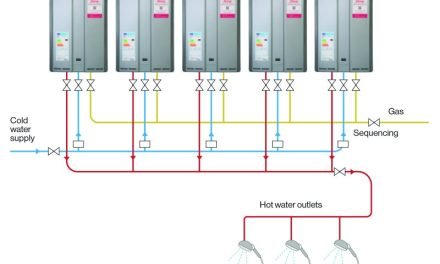A mechanical fan is machinery used to create flow within air. The fan consists of a rotating arrangement of vanes or blades which act on the air. The rotating assembly of blades and hub is known as an impeller, a rotor, or a runner; it is contained within a suitable form of housing or case. The fan housing (or fan case) usually directs the airflow and increases safety by preventing objects from contacting the fan blades. Fans usually produce air flows with high volume and low pressure, as opposed to air compressors which produce relatively high pressures at a comparatively low volume. A fan blade generally rotates when exposed to an air stream.
Axial versus Centrifugal
The axial-flow fans have blades that force air to move parallel to the shaft about which the blades rotate. Axial fans blow air along the axis of the fan, linearly, hence their name. This type of fan is used in a wide variety of HVAC applications. Axial flow fans are often applied for HVAC applications. Standard axial flow fans have diameters from 0.2 – 3 m.
Variable-pitch fans are often used in HVAC systems. A variable-pitch fan is used where precise control of static pressure within supply ducts is required. The blades are arranged to rotate upon a control-pitch hub. The fan wheel will spin at a constant speed. As the hub moves toward the rotor, the blades increase their angle of attack and an increase in flow results.
A centrifugal fan has a moving component (called an impeller) that consists of a central shaft about which a set of blades, or ribs, are positioned. Centrifugal fans are sometimes called a “squirrel cage” or “scroll fan” fans. Centrifugal fans blow air at right angles to the intake of the fan, and spin the air outwards to the outlet (by deflection and centrifugal force). The impeller rotates, causing air to enter the fan near the shaft and move perpendicularly from the shaft to the opening in the scroll-shaped fan casing. A centrifugal fan produces more pressure for a given air volume compared to axial fans. They are often typically quieter than comparable axial fans
Axial fan’s power characteristic is non-overloading. Axial fans are usually used in very low pressures and high flows. The vane axial and tube axial can be selected for higher outlet velocities than the centrifugal fans (as a very rough indication say even 10 m/s or more).The axial fans should usually be connected to ducts by tapered cone connection. The peak efficiency range of the tube axial is 30-55% vane axial is 40-68%.
Three types of centrifugal fan blades (radial, backward and forward) could be feasible which give three different characteristic performance types. The backward blade is usually well suited for many HVAC applications and it is used extensively. They are the most common blade types. The outstanding and important characteristic is the non-overloading power. The usual operating static efficiency range for the regular blade is 65-80% and for the streamlined design is 80-92%. Radial blades are sometimes used in special HVAC fans. They are not popular. Forward blades are not employed.
Design and Operation
Different arrangements and bearing supports have been used for fans. For instance, double-width, double-inlet or single-width, single-inlet can be mentioned. Overhung fan designs are usually used for small sizes. Between-bearing (BB) fan designs are employed for large units.
In any between-bearing fan designs, fan wheels are located between-bearings whereas the bearings are mounted on independently supported pedestals, and the bearings protected from the air stream. Generally in the fan design and selection of the fan arrangements the following should be considered
· Induced draft impellers should not usually exceed 750 mm diameter.
· Reduced speed is desirable for critical HVAC services.
· Fouling deposits which result in unbalance should always be respected and proper mitigations are required.
Fans should preferably be of “stiff shaft” design; in other words, the operating speed is usually less than the critical speed. There are high-speed fans with flexible shaft designs, but their applications should be limited to small and non-critical fans. Usually a wide operating range required for a HVAC fan. As a very rough indication, fans should have turn-down capability of 50% or less of the rated flow. A fan curve performance should have a continuously rising characteristic, the pressure versus flow plot, from the rated capacity to the surge. In many HVAC services, fans should be designed to allow installation of fan blade cleaning systems.
The fan scroll and housing should be continuously a welded plate construction. Strong and rugged fan housing designs are always preferred. As a very rough indication, plate thickness 3 mm, 4 mm or thicker should be used. For medium and large fans, bolted and gasketed access doors, minimum 600mm × 600 mm are required in the scroll and inlet box to access the fan internals for inspection, cleaning, rotor balancing and any internal bolting necessary for rotor removal.
Fan housings are usually designed to accept small external forces and moments from the inlet and outlet connections. The external loads that will be imposed on the fan housing from the ancillary equipment such as ducting, sound trunks, silencers, filters, etc should usually be limited. These items and fan housing should be designed in a way that the distortions resulting from imposed loads does not affect the fan’s performance and specifically no internal rubs result.
Forced-draft fans impellers may be provided with backward inclined or backward curved airfoil type. Induced-draft fans impellers may be radial, radial tipped, backward inclined, or backward curved airfoil type; with consideration of operation in possibly dirty air environment.
The fan control parameters could be a combination of inlet condition, discharge condition, flow. The fan control and capacity control are often accomplished by variable-speed, the suction throttling (by a damper or variable inlet guide vanes), or discharge bypass or adjustment. Variable fan speeds are well-known in many HVAC applications.
Guest blog by Amin Almasi, rotating equipment engineer.





